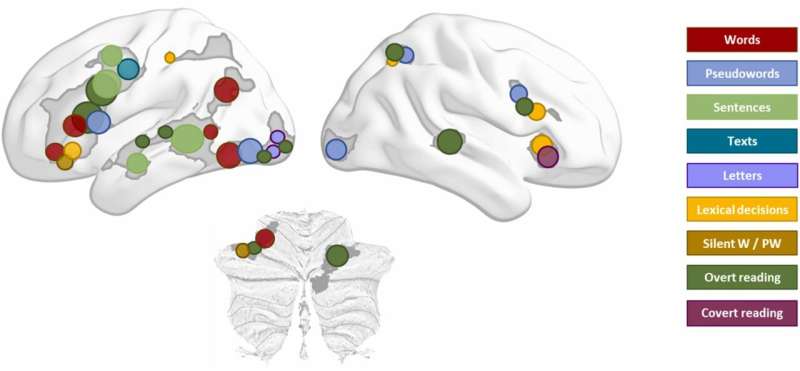Reading is a highly valuable skill that allows humans to acquire new knowledge, pursue an education and complete a wide range of real-world tasks. Many past psychology and neuroscience studies set out to better understand the neural underpinnings of reading and the intricate processes through which the human brain makes sense of written texts,
Researchers at the Max Planck Institute for Human Cognitive and Brain Sciences recently reviewed many of these previous studies to shed light on the overall brain activity patterns associated with reading. Their paper, published in Neuroscience & Biobehavioral Reviews, offers a comprehensive view of the brain regions and processes involved in different types of reading.
“Literacy provides the key to social contacts, education, and employment, and significantly influences well-being and mental health,” wrote Sabrina Turker, Beatrice Fumagalli and their colleagues in their paper. “Summarizing 163 studies, the present coordinate-based meta-analysis confirms the importance of classical left-hemispheric language regions and the cerebellum across reading tasks.”
As part of their recent study, Turker, Fumagalli and their colleagues analyzed the findings of over 150 studies that examined people’s brain activation patterns as they were reading a wide range of texts in different alphabetic languages, using various imaging techniques. In these studies, participants were asked to read letters, pseudo-words (i.e., words that don’t mean anything), words, sentences and entire texts.

“We found high processing specificity for letter, word, sentence, and text reading exclusively in left-hemispheric areas,” wrote the researchers.
“Subregions within the left inferior frontal gyrus showed differential engagement for word and pseudoword reading, while subregions within the left temporo-occipital cortex showed differential engagement for words and sentences.”
By reviewing previous literature, the researchers uncovered brain areas that are generally activated while reading and regions that contribute specifically to the processing of letters, words, pseudo-words, and entire texts. Specifically, they found that reading letters activated only one cluster of neurons in the left occipital cortex (OTC) while reading words, sentences, and entire texts also activated various other regions.
Moreover, Turker, Fumagalli and their colleagues unveiled differences in brain activation when people read aloud, also referred to as overt reading, and while silently reading in their mind, known as covert reading. For instance, they found that reading aloud often also activated brain regions linked to movement and sound processing.
“The direct comparison of overt and covert reading revealed higher activation likelihood in auditory and motor regions during the first, and more consistent reliance on multiple demand regions during the latter,” wrote the researchers.
“Last, silent word and pseudoword reading (explicit reading) yielded more consistent activation in left orbito-frontal, cerebellar and temporal cortices when compared to lexical decisions (implicit reading). Lexical decisions, in contrast, showed more consistent bilateral recruitment of inferior frontal and insular regions.”
The results of this research team’s review study provide an overall view of the neural architectures involved in different kinds of reading, which could inform future research to explore the unique involvement of these architectures further. Eventually, these works could also shed light on neural processes that differ in individuals who experience difficulties while reading, such as those diagnosed with dyslexia or other learning disorders, which could, in turn, help to devise interventions to support these individuals.
More information:
Sabrina Turker et al, The ‘reading’ brain: Meta-analytic insight into functional activation during reading in adults, Neuroscience & Biobehavioral Reviews (2025). DOI: 10.1016/j.neubiorev.2025.106166.
© 2025 Science X Network
Citation:
A comprehensive look at what happens in the brain when we’re reading (2025, May 4)
retrieved 4 May 2025
from https://medicalxpress.com/news/2025-05-comprehensive-brain.html
This document is subject to copyright. Apart from any fair dealing for the purpose of private study or research, no
part may be reproduced without the written permission. The content is provided for information purposes only.

